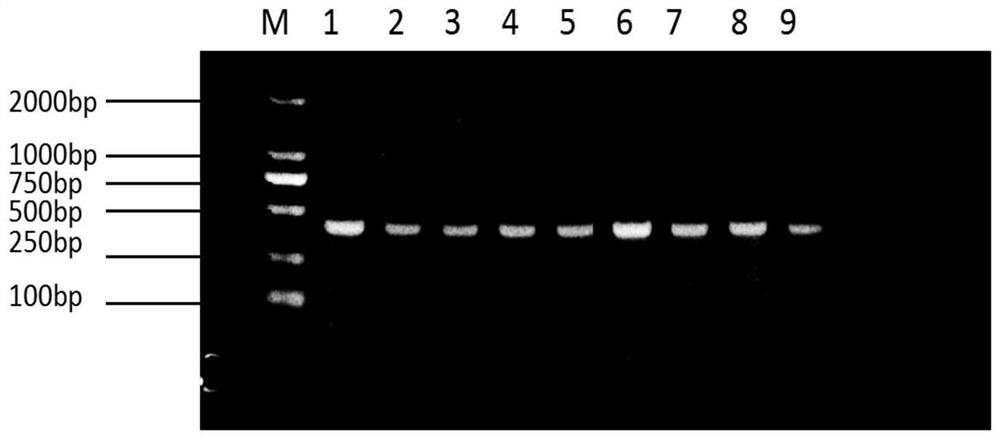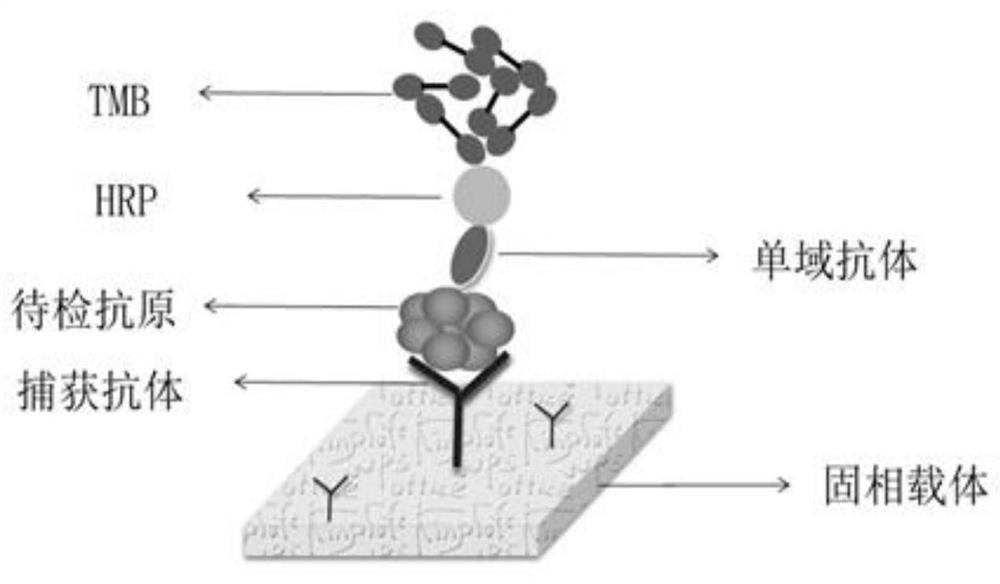Single domain heavy chain antibody for detecting porcine epidemic diarrhea virus, preparation method and application
A porcine epidemic diarrhea and single-domain heavy chain antibody technology, applied in the field of genetic engineering, can solve the problem of few epitopes of PEDVS protein, and achieve good antibody stability and specificity
- Summary
- Abstract
- Description
- Claims
- Application Information
AI Technical Summary
Problems solved by technology
Method used
Image
Examples
Embodiment 1
[0026] Example 1 (Construction of a PEDV-specific single domain heavy chain antibody library)
[0027] (1) Mix PEDV virus with Freund's adjuvant (Sigma), immunize one hump of Alxa Bactrian camel, immunize once every 10 days, and immunize 3 times in total. Freund's complete adjuvant is used for the first time, and Freund's complete adjuvant is used for the remaining two times. Incomplete adjuvant, the basic serum was collected before the first immunization, and the serum was collected one week after the last immunization to determine the antibody titer;
[0028] (2) After the 3 times of immunization, extract 150 ml of camel peripheral blood lymphocytes and extract total RNA;
[0029] (3) Reverse transcribe the total RNA into cDNA by RT-PCR;
[0030] (4) Using nested PCR to amplify the VHH chain, the size of the fragment is about 400 bp; figure 1 It is the detection electrophoresis diagram of the VHH gene fragment obtained by PCR amplification;
[0031] (5) Using restriction ...
Embodiment 2
[0033] Example 2 (screening PEDV single domain heavy chain antibody)
[0034] (1) Add 2 ml of transformed TG1 cells into 100 ml of 2×TY-AG medium, and incubate at 37°C for 2 hours;
[0035] (2) Add helper phage M13K07 for infection, the infection ratio is M13K07:TG1=20:1, and stand at room temperature for 30 minutes;
[0036] (3) Centrifuge for 10 minutes, resuspend the pelleted cells into 100 ml of 2×YT-AK medium, and culture overnight at 37°C;
[0037] (4) Centrifuge the culture solution at 2200 g for 30 minutes, take the supernatant, precipitate the amplified phage with PEG / NaCl, dissolve the precipitated phage in PBS solution, filter through a 0.22 micron filter, and store at 4°C for later use;
[0038] (5) Dilute the PEDV S protein with coating buffer and couple to the microtiter plate, and place it overnight at 4°C;
[0039] (6) Add 300 microliters of blocking solution to each well on the second day, and block at room temperature for 2 hours;
[0040] (7) Mix the phag...
Embodiment 3
[0043] Example 3 (screening PEDV S protein-specific clones by phage-ELISA method)
[0044] (1) Randomly pick 96 single clones from the cell culture dishes containing phages after the above three rounds of selection, inoculate them in 1 ml of 2×TY-AG medium, and culture overnight at 37°C;
[0045] (2) Transfer the overnight cultured bacterial solution into 1.3 ml 2×YT-AG medium and 10 9In four 24-well plates of M13K07, culture at 150 rpm at 37°C for 2 h, centrifuge at 1000 g for 20 min, resuspend the pellet with 1 ml of 2×YT-AK medium, culture at 250 rpm at 30°C overnight, and collect phage by centrifugation the next day supernatant;
[0046] (3) Mix the above-mentioned recombinant phage with blocking solution 1:1, add to a 96-well microtiter plate coated with 10 μg / ml PEDVS protein, incubate at 37°C for 1 h, add 100 μl to the negative control well 10 9 M13K07;
[0047] (4) Wash away unbound phage with PBST, 100 microliters of 1:5000 diluted HRP / anti-M13 monoclonal antibody...
PUM
 Login to View More
Login to View More Abstract
Description
Claims
Application Information
 Login to View More
Login to View More - R&D
- Intellectual Property
- Life Sciences
- Materials
- Tech Scout
- Unparalleled Data Quality
- Higher Quality Content
- 60% Fewer Hallucinations
Browse by: Latest US Patents, China's latest patents, Technical Efficacy Thesaurus, Application Domain, Technology Topic, Popular Technical Reports.
© 2025 PatSnap. All rights reserved.Legal|Privacy policy|Modern Slavery Act Transparency Statement|Sitemap|About US| Contact US: help@patsnap.com



